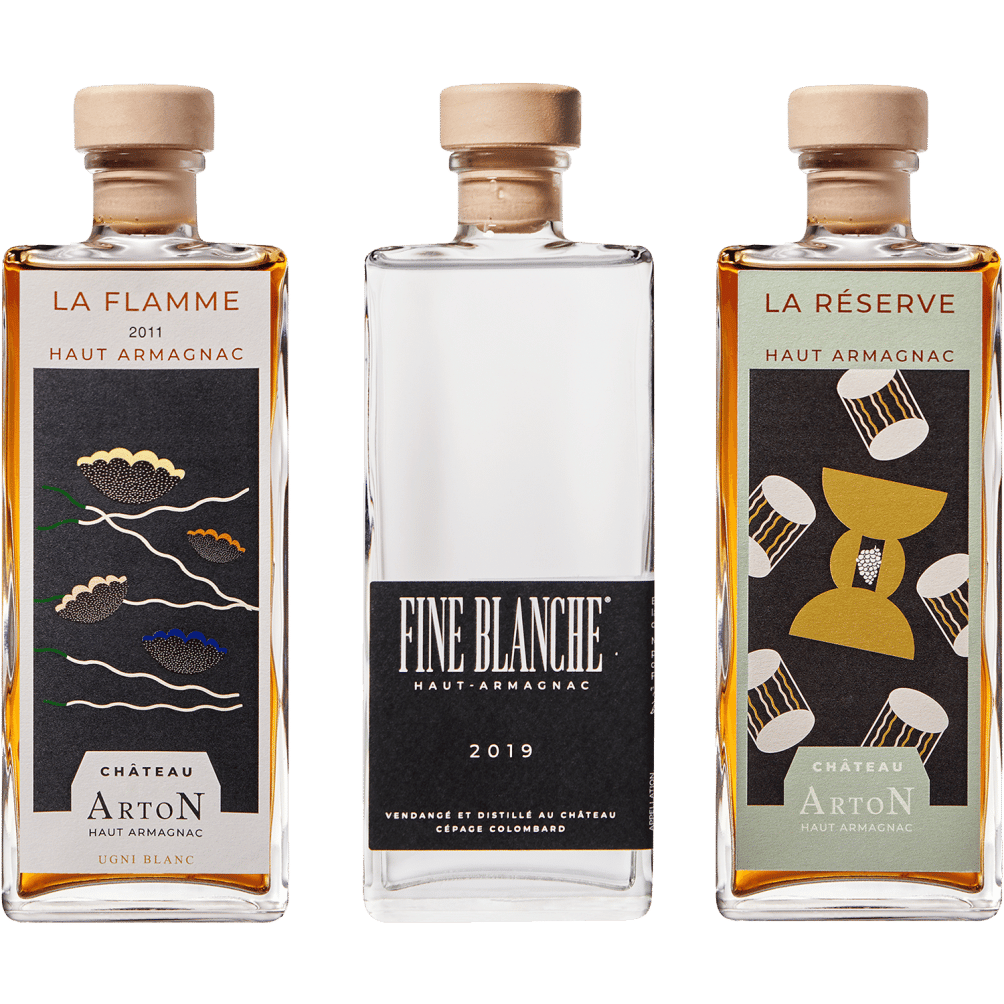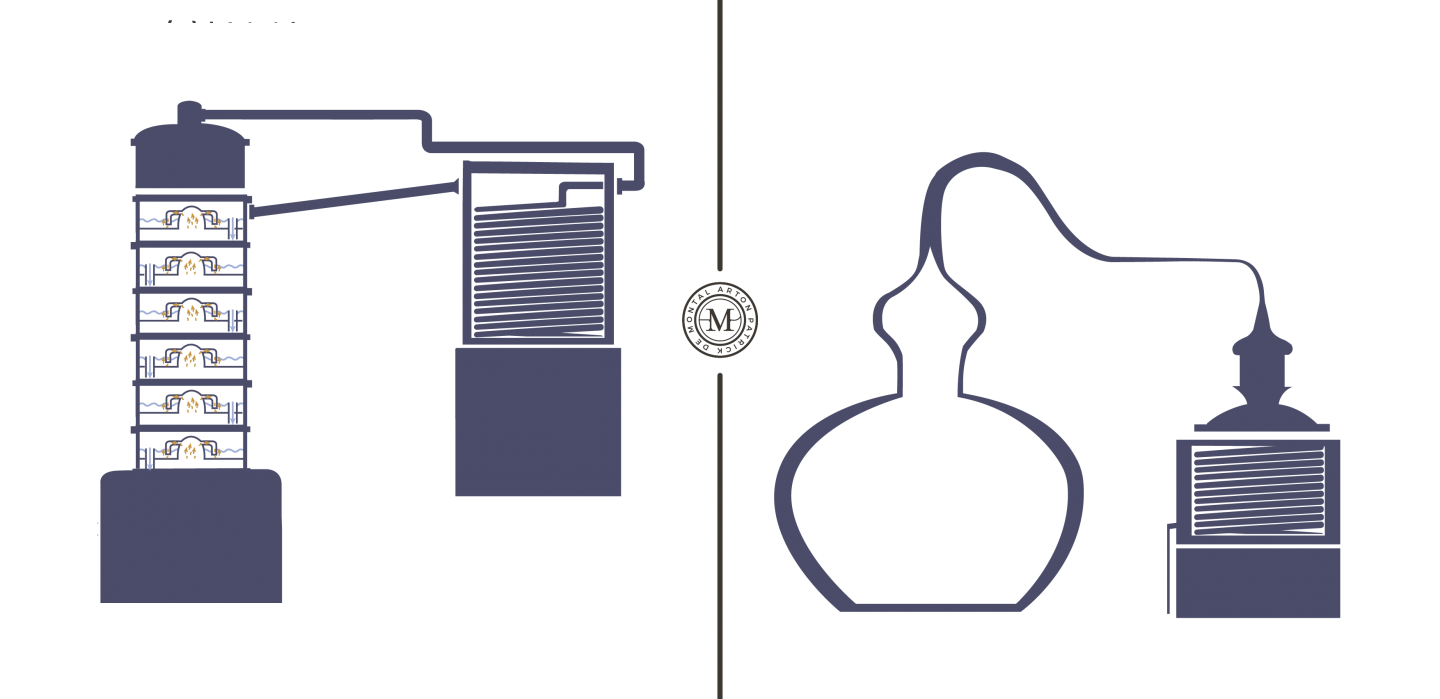
Armagnac, Cognac, Whisky: What is the Difference?
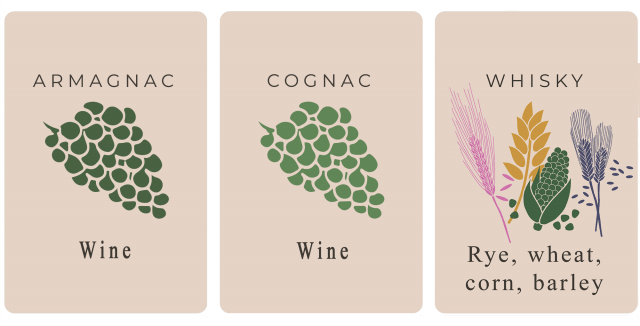
Armagnac and Cognac are both Appolation-protected spirits distilled from white wine, aged in wooden casks, and produced exclusively in France. Their maturation depends on the changing seasons, and slow changes in temperature and humidity. This process elevates the work of the vine, the harvest, the vinification, and the distillation. A decree defines the distillation period of the base wine as from the end of the harvest (October) to the following March 31.
Whiskey is a grain-based spirit aged in a wooden barrel. It is produced from grains (usually barley, maze, or rye). Like other grain-based spirit like Gin or Vodka, it can be distilled all year round. Its production does not depend on a specific terroir or seasons. It can be produced anywhere in the world, which explains its great geographical diversity (Ireland, Scotland, Japan, France, and the US for example.).
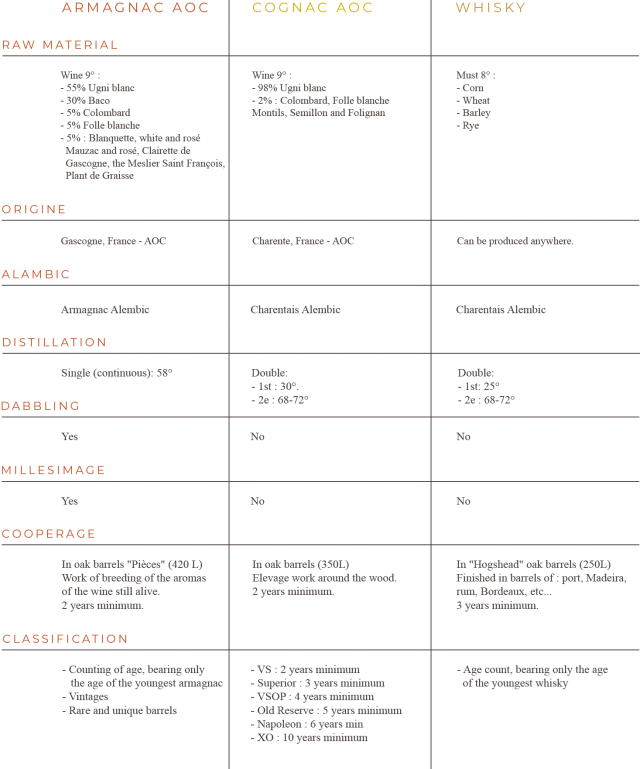
If Armagnac and Cognac are clearly distinguished from Whisky, it is not always easy to differentiate these French brandies from one another. Let’s discuss the 7 key points that make each category unique.
1. ARMAGNAC VS COGNAC : DISTILLATION
Armagnac and Cognac eaux-de-vie come from two distinct stills. This is their fundamental difference. The distillation process specific to each determines the specific qualities of these unaged spirits. Armagnac is distilled only once, in an Armagnac still (with columns), while Cognac is distilled twice, in a Charente still (which does not have columns).
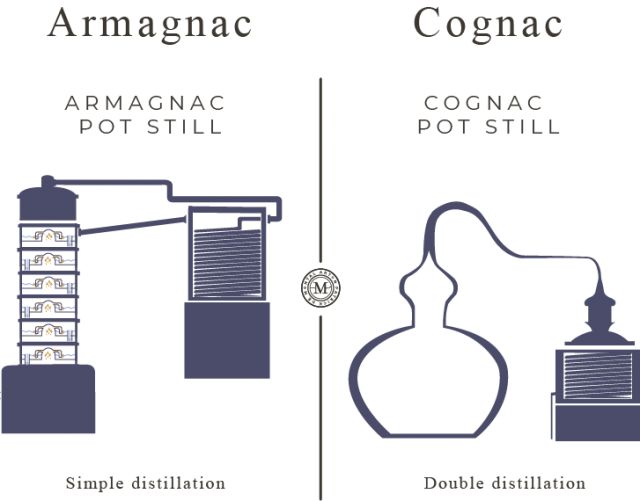
The Armagnac Alembic, or “Alembic Armagnacais,” as the locals call it, is a copper still with columns and plates, and distills wine using a single “continuous distillation” during a single distillation pass. It should be noted that this is a very different still than the large industrial column stills used for creating high-proof neutral spirits.
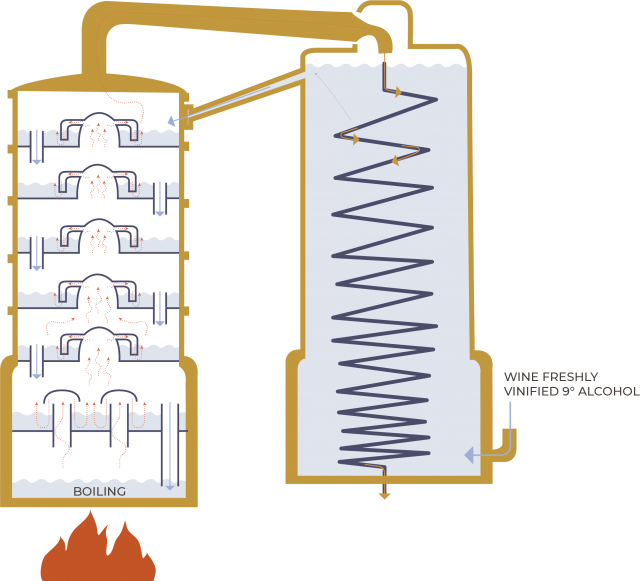
During the Armagnac distillation, the freshly vinified wine is brought to the boil. Its vapors rise and pass through trays where they pass through the fresh wine: this is what is referred to as Barbotage, or bubbling.
The vapors are thus infused with the aromas of the fresh wine, and preserve the organic, mineral, and vegetable components of the wine which will give it all its aromatic power. At each plateau, they are enriched a little more and arrive at the top of the column saturated with aromas. Then the vapors condense to flow out of the still at 56% alcohol. It is one of the lowest proof alcohol distillates in all spirits, preserving the living aromas of the wine. This eau-de-vie is then housed in oak barrels where it will blossom and take on the color of the wood to become Armagnac.
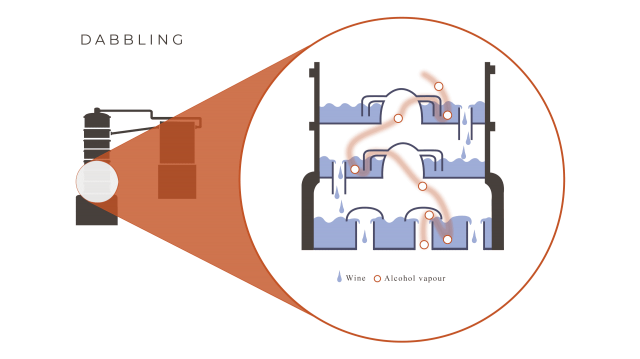
The “cognaçais” or “charentais” still is a copper still that uses a method referred to as Repassing, or double distillation, because the alcohol is distilled through the system twice. Once the wine has been brought to the boil, the vapors escape to the condenser directly, without encountering any undistilled wine like in Armagnac. This first distillate, called “brouillis” in French, or “Low Wines” in English, contains between 27% and 32% alcohol. It is again loaded into the still for a second distillation. The fractions at the start (“the heads”) and at the end of the distillation (“the tails”) are discarded. The “heart” of the distillation, that is to say, the distillate that flows between the two, comes out of the still at around 72% alcohol. Housed in an oak barrel, it is enriched with the aromas of wood to become Cognac.
2. ARMAGNAC VS COGNAC : #ARMAGNACISNOTBRANDY
“Armagnac seems to be part of the brandy culture. I think it is part of the wine culture”. Patrick de Montal
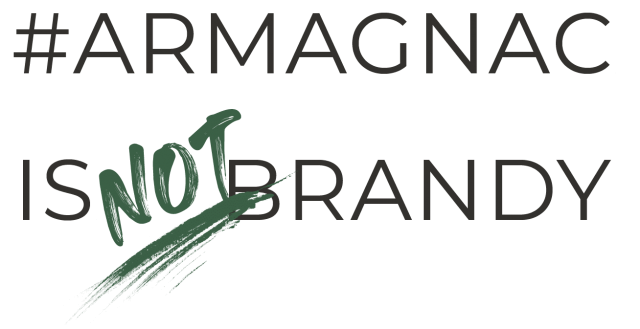
Armagnac is the closest spirit to wine. This spirit evolves and grows with age because it retains the living organic matter of the fresh wine from which it is made. This particularity gives Armagnac a real uniqueness, that of being able to evolve over time like a fine wine.
This “living” eau-de-vie ( French for “spirit,’ literally “water of life”) reflects the expression of a year. This is why Armagnac can fully justify bottling in vintages, its aging contributes a unique complexity. This is what links it to the culture of wine and distinguishes it from other spirits, like cognac or rhum, which are distilled to a higher proof and thus lose the vibrant, living character of the base.
3. ARMAGNAC VS COGNAC : The aging
On leaving the still, the Armagnac and Cognac eaux-de-vie are housed in oak barrels. The principles of aging are similar. Armagnac and Cognac evolve in new or old barrels, alternating between dry cellar and wet cellars to manage evaporation. During aging, exchanges take place between the oak and the young spirit, developing the aromas and naturally coloring the spirit.
While Armagnac comes out of the still at 56% alcohol, Cognac comes out at 72% alcohol. However, both are consumed at around 45% alcohol. The natural evaporation of alcohol during aging allows the Armagnac to gently tend towards 40-45% where it is bottled, with a slight addition of distilled water when necessary. Some Armagnacs and Cognacs, known as “bruts de cask,” or “Cask Strength,” are made without adding water.
The aging of Armagnac highlights the character of the “living” wine still present in the spirit. The influence of the wood is directed so that it does not take precedence over the natural aromatic power resulting from the wine. On the contrary, the aging of Cognac, like that of Whisky, is centered on the development of wood aromas.
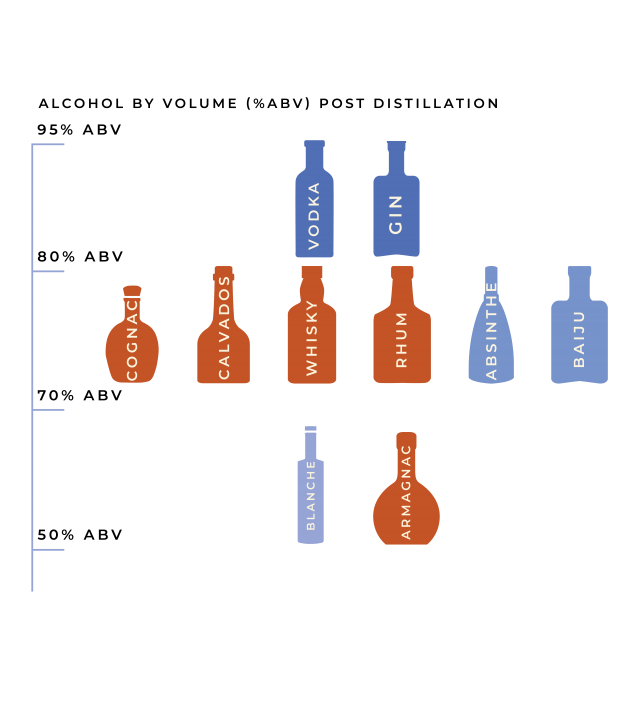
The Cellar Master defines the maturation period of the young Armagac, leading them through their aging towards the flavors and character that is their signature.
Neither Armagnac nor Cognac get their aroma or character from artificial or introduced flavors. They derive their flavors exclusively from the distilled wine and the oak in which they age. In this, they differ from industrial spirits (Gin, Vodka), neutral grain alcohols characterized by the natural or artificial addition of flavors.
Once bottled, both Armagnac and Cognac cease to age.
4. ARMAGNAC VS COGNAC : AGE COUNTS
Cognac is made from the blending of spirits of different ages and vintages. It’s age classification is determined by the youngest spirit in the blend. So if you take 100 casks of 50-year-old Cognac, and blend them with 1 cask of 2-year-old Cognac, you can only label it as 2 years old, or a VS.
Cognacs are classified by age of aging according to statements standardized and controlled by the BNIC (Bureau National Interprofessionnel du Cognac):
- VS : at least 2 years of aging in wood
- Superior : at least 3 years of aging in wood
- VSOP : at least 4 years of aging in wood
- Old Reserve : at least 5 years of aging in wood
- Napoleon : at least 6 years of aging in wood
- XO : at least 10 years of aging in wood
Behind these acronyms, however, hide the specificities of aging for each producer. Many producers bottle their blends at the minimum, but many prefer to age further. Some VSOPs may be 7 years old, some may be 4 years depending on the producer.
Armagnacs, which can be blended or vintage, are not subject to the standards of age accounts like Cognac. And for good reason!
Like Cognac, Armagnac can be made from a blend of different ages and vintages. Its label then indicates an “age count” (7, 12, 18, 30 years…) reflecting the youngest spirit used in the blend. This similarity with Cognac explains why some Armagnac houses choose to borrow the denominations of Cognac (VS VSOP, etc.) for their blends, a practice allowed by the BNIA (Bureau National Interprofessionnel de l’Armagnac).
Cognac, however, Armagnac is commonly vintage: the cuvées then come from a single year of distillation. Thanks to the uniqueness of the craft, which allows Armagnac to showcase the flavor of the wine from which it comes while the imprinting the vintage, the signature of the terroir, and the flavor of the grape variety into the spirit, which is why we call it the “eau-de-vie,’ or the water of life. Armagnac is vintage-dated, like a fine wine, to reveal this unique aromatic palette linked to the evolution of the wine that is still alive in the aging Armagnac. Vintage Armagnac sometimes comes from a single, unblended cask. It is then called “Rare Fût Unique” or “Unique Piece” meaning “Single Cask.” The date of the vintage (year of harvest of the grapes), which we consider more significant than the duration of aging, is written on the label just as in wine. The aging time of a vintage is not regulated by a specific age count. Most Armagnac houses publish vintages that have aged well more than 10 years. At the Domaine d’Arton, we publish young vintages because our unique terroir and unique philosophy allows us to do so. We believe that the quality of Armagnac does not depend on its age, but on the mastery of each stage of its development from the vine to the wine, and from the wine to the Armagnac.
The structure of our range of Armagnacs testifies to our purist vision, a vision that has become our signature. We believe that the best Armagnac is one that requires no blending. This is why we publish our Vintages as “Single Cask”. These are the most natural and authentic expression of our terroir and the vintage. Our mastery of the entire production – from vine to wine and from wine to Armagnac- allows us to achieve this level of excellence.
The selection of these Single Casks is deeply rigorous and follows a meticulous tasting process that spans the cask’s 10 years in our cellars.
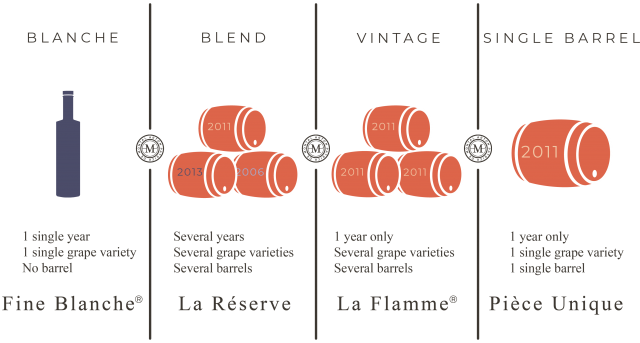
- Year 00: we distill our Blanche Armagnac. Part of this Blanche is bottled under our Fine Blanche® brand. The rest is put in barrels to age.
- Year 06: after tasting, we assign certain barrels to our “La Réserve®” blend. These barrels did not show enough potential to be vintage and need to be blended to achieve the balance and complexity we look for. The other barrels continue their aging.
- Year 10: after tasting, the most remarkable barrels are selected to become one of our “Single Cask” Armagnacs. The others are blended to form our “La Flamme®” vintage.
5. ARMAGNAC VS COGNAC : THE TERROIRS
Armagnac and Cognac are French AOC spirits, or appellation d’origine contrôlée spirits, meaning they cannot be produced outside their region.
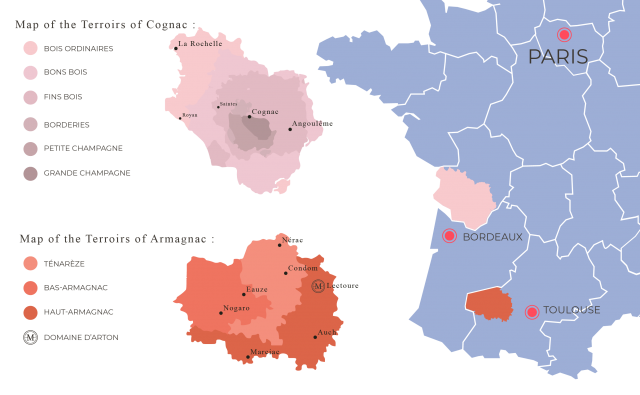
300 km separate the two territories. The Armagnac region is located in the province of Gascony (in the Gers department, the eastern portion of Landes, and the southern part of Lot-et-Garonne departments). The Cognac region is further north (Charente, Charente-Maritime, part of Dordogne and Deux-Sèvres departments). The terroirs are distinguished by their soils and their climate, giving the spirits their own character. The Cognac soil is largely homogeneous, dominated by limestone, while the Armagnac soil is sandy, clay-siliceous, and clay-limestone. The diversity of the Armagnac soils, divided into three terroirs – Haut-Armagnac, Ténarèze, and Bas-Armagnac – gives the Gascon spirits a wide variety of nuances that mark its originality.
The AOC appellation requires that these spirits be produced in compliance with regulated specifications guaranteeing their origin and authenticity.
6. ARMAGNAC VS COGNAC: THE GRAPE VARIETIES
Armagnac is a distilled white wine from Gascony, heated in an Armagnac still, then aged in oak barrels. It is made from a number of grape varieties (10 grape varieties fixed by the AOC) including Ugni Blanc (55%), Baco (30%), Colombard (5%), Folle Blanche (5%), and older, rare grape varieties which are: Blanquette, white and rosé Mauzac, Clairette de Gascogne, Meslier Saint François, Plant de Graisse. Ugni blanc comes from the Cognac region but was widely planted in the Armagnac region after the ravages of phylloxera at the end of the 19th century.
Cognac is made almost exclusively from Ugni Blanc. This grape variety makes up 98% of the Cognac vineyard.
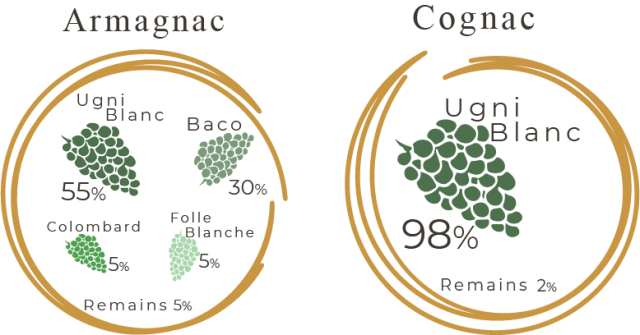
The diversity of Armagnac grape varieties is due to the wine-growing tradition of the region, which above all produces a wine intended for drinking. The Cognac region mainly produces wine for distillation, so there is less reason to grow varieties like Colombard.
7. ARMAGNAC VS COGNAC : TWO FRENCH BRANDIES, TWO HISTORIES
Armagnac is the oldest French brandy! Its production has been attested since 1310 when its medicinal virtues were praised by Vital du Four, a Franciscan theologian in Eauze. In the space of a century, this apothecary’s remedy became a drink appreciated for its taste, a precious spirit developed on the fringes of the region’s wine production.
Cognac has a very different historical trajectory which influences its current prevalence. While Armagnac developed in the countryside being produced by and for rural people, Cognac has established itself on a commercial export model to the Netherlands and England. In the 16th century, when the English controlled Bordeaux, Charentes wine was exported by the Dutch to northern Europe from ports on the Atlantic coast (La Rochelle). It was distilled to be preserved and travel without spoiling. This spirit was then diluted with water to be consumed like wine. But Cognac as we understand it now only really emerged in the 18th century, with the appearance of double distillation borrowed from Whiskey and aging in oak barrels. Designed for an export market, England’s economic and population growth lead to a growing thirst for fineFrench spirits. Merchants from across the Atlantic set up trading companies specializing in the production of Charentaise brandy in Cognac. Under Napoleon III, a trade treaty signed between France and England (1860) boosted the export of Cognac. Today, 98% of its production is exported.
8. AN EDUCATIONAL BOX
To learn everything about our Armagnac, buy this initiation box
This unique collection reveals the flavor nuances of Armagnac, from the unaged FIne Blanche to the 10+ year old vintage.
Château Arton Haut-Armagnac is in the Gers. Grower-Producers since 1991, we are currently in conversion to biodynamic cultivation and permaculture.
